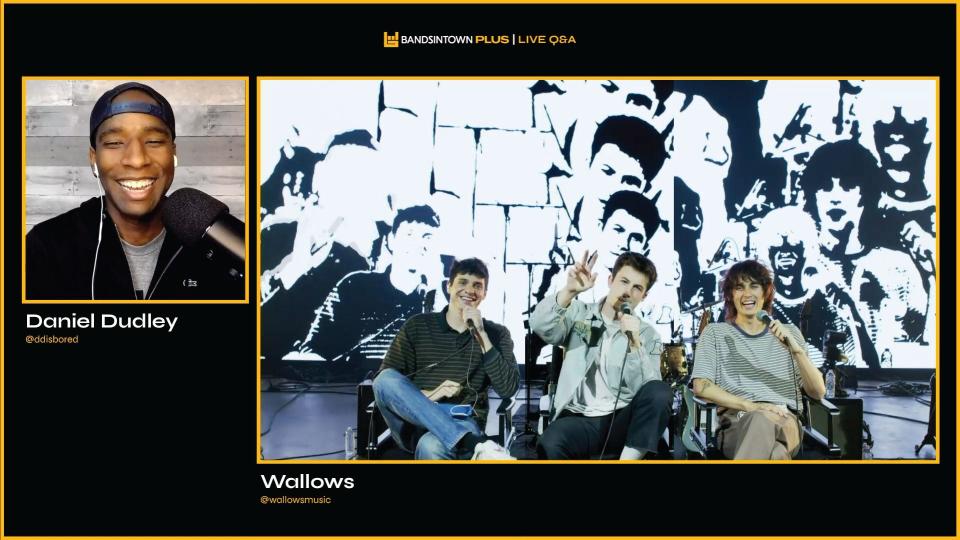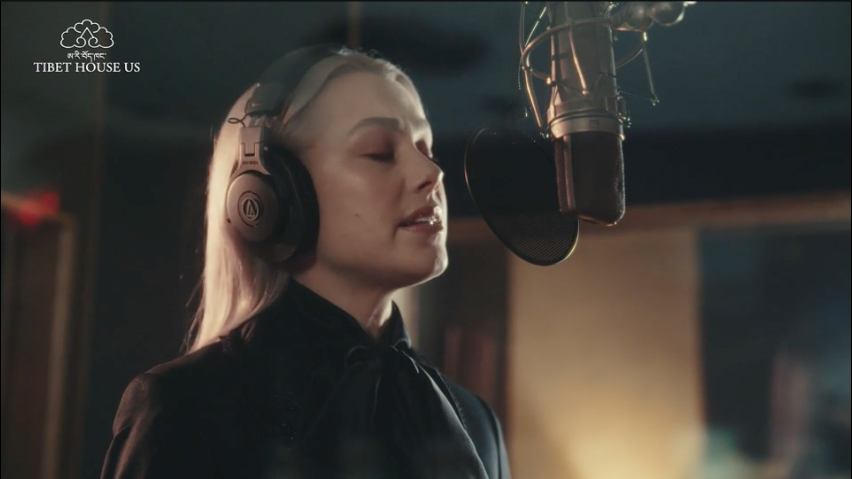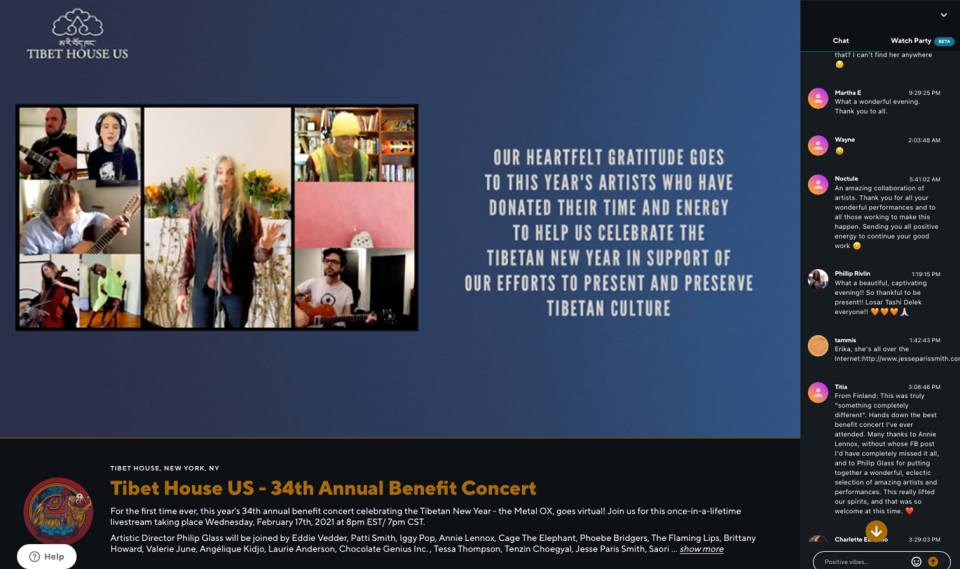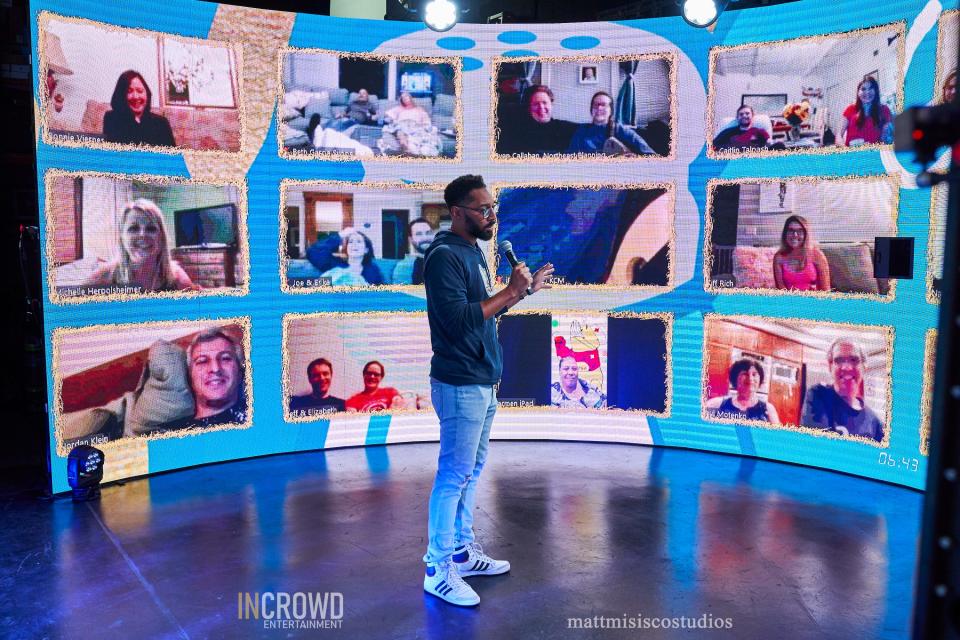What will live entertainment look like after COVID-19? Hybrid events for in-person and streaming crowds, plus more Zoom
Americans are getting COVID-19 vaccinations in record numbers. Music venues and comedy clubs have begun preparations to reopen.
Many of us are suffering Zoom fatigue will soon be able to get off the couch or out of our home office chair, abandon those livestream events and hotfoot it to the clubs.
Not so fast. For starters, not all venues are opening 100%, which makes sense considering only about 19% of Americans are fully vaccinated.
More importantly, we kind of like our livestream events.
"It really felt like we were just sitting in Brandi's home," said Mark Neese of Okemos, Michigan, about streaming Brandi Carlile's Christmas show in December. "What the livestreams lack in the electricity of a live show, they somewhat make up for in that there are no crowds, no lines and no annoying drunk and/or overly talkative audience members."

After streaming YouTube comedy show "Zoomin' With the Homies," Brittany Wooten of Phoenix and four of her friends bought VIP tickets to a livestreamed comedy roast.
The women got to have their Zoom feeds displayed on a giant video display curving around the stage where the comedians performed. Wooten said it was "a great way for all of us to stay connected and support each other. I want more of it."
Many of the comedians who performed for the event have cultivated a following during the pandemic.
This year, Swedish band The Hives did a “World Wide Web World Tour” playing livestreamed shows for different time zones. "They had all the energy and crowd interaction of a normal show," said Michael Byars of Kansas City, Missouri, who watched the finale streamed from the band's hometown of Stockholm.
Streaming comes alive during COVID-19
Before the pandemic, concerts were occasionally livestreamed. YouTube delivering much of the 2019 Coachella Festival. Once music lovers and musicians were in lockdown, streaming of live performances exploded as artists and bands sought to offset canceled 2020-2021 tour itineraries.
Some such as David Gilmour and Richard Thompson used Facebook to stay connected with fans. Others such as Margo Price and Amanda Shires posted from their homes onto YouTube and Instagram.
In August 2020, Los Lobos singer and guitarist Cesar Rosas summed it up perfectly, telling an online crowd during a full-band electric performance at the Belly Up music venue, where only the technical crew and staff were in attendance, "This is all strange, but we miss you guys."
As gigs exploded, some nights, a fan had to choose between three or four shows to pay to livestream. For artists, "streaming is going to be a … part of the musical landscape going forward," said Lee Totten, chief creative officer for webcast provider BubbleUp, which helped produce the Los Lobos show and has been livestreaming Jimmy Buffett performances for six years.
Since March 2020, more than 22,000 artists have performed more than 79,500 concert livestreams on Bandsintown, the online music hub said. More than half of music fans (55%) said they will keep streaming live concerts after in-person shows return, according to a Bandsintown survey in March of about 6,000 fans and 1,000 artists.
Most artists surveyed (85%) plan to maintain livestream shows as part of their schedules even after in-person shows are doable.
Bandsintown is so confident of the livestreaming future that it launched a $9.99 monthly Bandsintown Plus subscription streaming service to watch shows and get perks such as artist chats.
"Livestreaming has become a permanent part of an artist performing and marketing schedule that will continue long past the pandemic," said Fabrice Sergent, Bandsintown co-founder and managing partner. "We hear this from labels, artists and fans."

Think you have a lot now? Americans will add even more streaming subscriptions in 2021
Making music and history: In her return, singer Shontelle deploys NFTs in song of empowerment
Fans have made livestreaming part of their lockdown lives. While traditional on-demand video, such as watching Netflix or YouTube grew 91%, traffic sent upstream from the home – video streams of remote work, school and watching live entertainment – increased 145%, according to network management company Sandvine.
"Everyone’s process around working from home and being digitally connected has been ironed out through this pandemic," said Veroljub Mihajlovic, a senior product marketing manager at Sandvine. "What we are going to be seeing is that this video that is connecting us is going to be here to stay. … We have transitioned and we are transitioning to being a video-first economy."
COVID-19 an 'accelerant' for livestreams
The annual Tibet House US Annual Benefit Concert had always been a live event, but as fall 2020 arrived, the coordinators were concerned. Carnegie Hall, where artists such as David Bowie, the Roots, FKA twigs and Lou Reed had performed over the event's 33-year history, wouldn't be open to audiences by the date of the show, planned for February 2021.
Composer Philip Glass, the event's artistic director and vice president of the Tibet House, and special events director and producer Kyra Borre decided to stream a virtual concert.
After talking with several production companies, Tibet House settled on Mandolin, a music streaming startup. "COVID was a real accelerant of livestreaming," said Mandolin CEO and co-founder Mary Kay Huse, a former chief operating officer at Salesforce – a fortuitous connection as the Tibet House had worked with the firm.
Mandolin emphasized the production of premium sound and video quality, as well as interactive features including meet-and-greet chats with artists, merchandise sales and special "watch party" chatrooms for friends to text one another onscreen.

For the festival, Mandolin helped capture separate performances by Glass, Patti Smith, Phoebe Bridgers and others in New York and Los Angeles and Pearl Jam frontman Eddie Vedder in Hawaii. Actress Tessa Thompson provided narration from Australia for a song performed by her father, Marc Anthony Thompson, who performs as Chocolate Genius. All the performances were recorded and presented as a program with a special message from the Dalai Lama and an invocation by Tibetan Buddhist monks from the Drepung Gomang Center for Engaging Compassion in Louisville, Kentucky.
"Surprisingly intimate" is how Tibet House director Beata Tikos described the event. Pay-per-view proceeds surpassed the previous efforts; attendees could donate and buy merchandise, including T-shirts.
Streamers like sound of hybrid shows
Tibet House benefit planners expect livestreaming will probably be part of next year's festival, Tikos said. "The idea is to do a hybrid event," she said, because of the global reach – they sold online tickets in Japan, Singapore, Hong Kong, and India.

Hybrid events just make sense for promoters, performers and fans, Huse said. In addition to pre-show or post-show meet-ups for attendees with artists, some events let customers pay to watch pre-concert sound checks. "There's just all sorts of experiences surrounding a show that the digital media has unlocked, being able to drive these interactions that the fans love and are willing to pay for," she said. "Therefore, the artists make a lot of money from it."
Think of concerts like sports events, Huse said. Some pay to attend, and others watch from home. Mandolin's recent and upcoming shows include Dionne Warwick, Emmylou Harris and Steve Earle, the Blind Boys of Alabama and Mario.
"The touring and in-person shows coming back is actually only going to help accelerate our business because people have seen the virtual experience is great," Huse said.
The more interactive the event, the more likely artists – and fans – will enjoy it. In May 2020, when singer-songwriter Jason Isbell and wife Amanda Shires did a livestream performance from Nashville's Brooklyn Bowl, they could see some fans watching on several big-screen displays.
Shires, who had been performing online gigs from the family barn, much preferred to see at least some of the crowd. "We didn't have that with the barn shows. It's awesome," she told the audience.
Even though vaccinations are expanding, fully attended concerts "might still be a year away," says Bill Demas, CEO of streaming analytics firm Conviva.
Single-purpose concerts will become less frequent, and instead, promoters will create "some form of hybrid concert, where you can also watch it online live or later on demand," he said. Concerts can be "packaged up and redistributed on demand later."
Zoom ... but on steroids
Mandolin isn't the only player looking at hybrid events. In January, concert giant Live Nation acquired, for an undisclosed price, a majority stake in livestreaming platform Veeps, which hosted about 1,000 ticketed shows in 2020, generating $10 million in revenue.
“Livestreaming is a great complement to our core business and essentially gives any show an unlimited capacity," Live Nation President and CEO Michael Rapino said at the time.
The promoter partnered with Verizon to deploy 5G connections within 15 well-known clubs, including the Wiltern in Los Angeles, the Fillmore in Miami and Irving Plaza in New York City. Viewer control over multiple camera angles will provide "a whole new way of experiencing music and watching performances both live and on-screen," CEO Hans Vestberg said in announcing the deal at the CES Show in January.
"As live music comes back, we will be ready to help make it better than ever," he said.
Neither Verizon nor Live Nation would comment about specifics, but it's not much of a stretch to see those feeds made available to online viewers.
About AT&T, Verizon and T-Mobile: The 5G battle between US carriers just got very interesting
Music appreciation: Amid cassette tape creator's death, we remember his legacy – the mixtape

InCrowd, which produced and streamed the comedy roast attended by Wooten and more than 6,000 others, is expanding its vision, too.
Comedy shows produced by InCrowd are like Zoom on steroids – performers command a 40-foot-by-40-foot stage in Los Angeles, a few minutes from Los Angeles International Airport and SoFi Stadium. Curving around the stage is "The Wall," a giant video display of up to 300 VIP ticket holders.
The performers are "surrounded with their fans," said Ryan "Bubba" Ginnetty, an event producer and comedian, who consulted with Zoom after the pandemic's onset and created the venue.
In a real comedy club, the comics can't always see the crowd, but "here you can play off their facial reactions," he said. "It's adds a different type of reaction and validation."
InCrowd has produced about 75 live entertainment events; each can accommodate up to 50,000 ticketed attendees; non-VIP General Admission attendees not seen on "The Wall" still watch. Capacity could increase, as Zoom expects to expand to 100,000 – 10,000 more than Wembley Stadium holds. InCrowd has multi-streaming capabilities and can livestream to millions on multiple platforms at once.
Just as Zoom work from home can lead to children popping up in a video feed, so can livestreamed entertainment events produce singular moments. Early in the InCrowd roast, a baby crying could be heard. "Whoever got babies got to mute that (expletive) right now," said actor and comedian Tone Bell ("The United States vs. Billie Holiday"), who has done several InCrowd shows. "You all act like you haven't been zooming for a year."
Reflecting on it later, Chris Spencer, a comic and writer who participated in the event, joked, "Nobody wants to be heckled by a toddler."
InCrowd is in talks with potential partners and investors and plans to expand its production stages to other cities such as New York, Nashville, London and Paris. Content could be made available on traditional streaming services such as Netflix.
"This was designed for comedy, but I knew it was applicable to all genres," Ginnetty said. InCrowd has produced music events, talk shows and events such as the Cystic Fibrosis Foundation Comedy Fundraiser in October 2020 and the HBO Latino Comedy Competition in December 2020. Upcoming events include "Hollywood Homecoming," a digital series that reunites casts of Black films ("The Best Man" reunion airs Tuesday on the American Black Film Festival's new ABFF Play streaming service and Amazon-owned IMDB TV); the Ambie Podcast Awards on May 16; and the Los Angeles Comic Con in September.
InCrowd is not without competition. This week, Worre Studios in Las Vegas announced the opening of a 25,000-square-foot arena capable of hosting 250,000 interactive audience members for virtual and hybrid events.
Zoom's own professional services team helped "American Idol" hold auditions across the USA and helped produce Oprah's WW virtual tour.
"A lot of people think this is a supplement," Ginnetty said. "We think this lives far on beyond the pandemic."
Follow Mike Snider on Twitter: @MikeSnider.
This article originally appeared on USA TODAY: Are we keeping Zoom? Post-pandemic entertainment may not look the same

